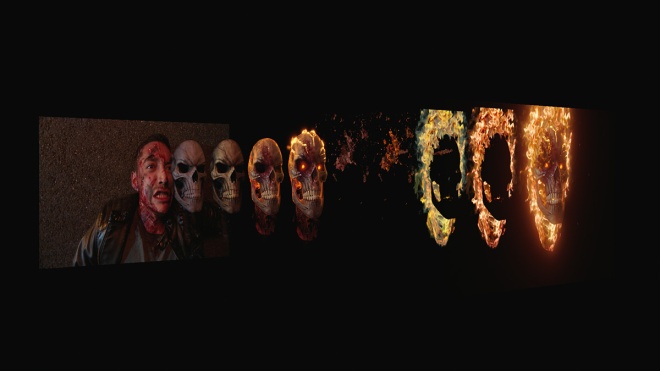
Last year, the Marvel character Ghost Rider burst onto the small screen in ABC’s Agents of S.H.I.E.L.D. for seven episodes of the series. The fiery effects required to bring Ghost Rider (played by Gabriel Luna) to life were orchestrated by FuseFX. In this special vfxblog breakdown, FuseFX visual effects supervisor Kevin Lingenfelser dives into how the character’s fire effects and transformations were achieved.
Ghost Rider tests
Over 100 hundred heavy fluid simulations were tested and refined to eventually setup an efficient FX pipeline that could handle nine layers of fire, smoke, and ember elements necessary for the character design of Ghost Rider. For Look-Development purposes we utilized a live action shot from season 3 with Brett Dalton walking that we match-moved and composited the CG skull, FX flames and smoke renders onto before any plates for ep401 were even shot.
Concept design
Marvel’s in house concept artist, Joshua James Shaw, did initial designs with input from Production VFX Supervisor Mark Kolpack and myself. FuseFX CG Artist Matt Lefferts built the Skull from Marvel’s drawing and refined it during Production. We did reference the feature films, the 2nd being the more useful. But, ultimately since this was the Robbie Reyes version of Ghost Rider, and not Johnny Blaze, we took inspiration from the current run of comics and Robbie Reyes’ unique look.
Shooting methodology
Upon talking with Mark Kolpack it was decided that it would be in everyone’s best interest not to limit or hinder in any way Gabriel Luna’s range of motion while playing Ghost Rider. We also knew in advance that once transformed into Ghost Rider he would not speak, which was a creative choice (partly based on it not working that well in the films) and the lack of voice made him more menacing as he stalked his prey.
On-set
Two masks were created by Production for Gabriel to wear. Both had four strips of LED lights for interactive glow and falloff onto his leather jacket. It also only had his eyes and partial forehead and nose exposed. Mark added tracking dots to his facial features to help facilitate match-moving which was done by long time FuseFX collaborators YANNIX. A second mask was created once we saw the lack of facial expression that was visible when using the first mask. So the mask was cut to allow all of Gabriel’s facial features to be seen and used to facilitate Ghost Rider’s expressions.
Fire sims
The Ghost Rider character necessitated heavy CG fluid simulations to create his distinctive pyrotechnic features. Each of his Fire, Smoke and Ember layers could take up to 10 hours to compute. The skull, neck, spine and eyes each required a specific FX rig to account for art direction from myself, CG Superviors Chad Wanstreet and John Decker and finally Mark Kolpack and the shows EPs. And those were all able to be refined on a shot by shot basis to accommodate for massive range of motion, from the simplest of stances, to a walk, to the most extreme and complex fight sequences.

Additional CG and 2D techniques were utilised to allow for the skull’s facial features to emote, as well as additional FX elements for precisely timed flame flareups erupting from the jaw. Directing a fire simulation carried by a dynamic character is an extremely arduous and tedious task. In order to force the fluid to follow certain paths for artistic factors like the the fire flaring around each side of the face, we sculpted in space, directional vector fields with the sole purpose to contain and direct the fluid that passes through as artist sees fit.
Transforming into Ghost Rider
With at least one transformation shot every episode a system to burn the flesh off Robbie had to be created to be highly, and easily art direct-able in terms of the direction and areas he would burn the skin off from. A custom tool was created by FX Supervisor Slim Ghariani and FX artist Bruce Coy to allow the creation of a gradient that had multiple points of origin and weighted strengths to control the timing.

This gave us the ability to pick where and when the transformation would occur, and how far and fast they would spread using a combination of procedurally generated and painted values. We were able to visualize these attributes in real time for quick iterations based off feedback from the client. Once the timings were approved we were able to create multiple attributes from these gradients that were used to drive all the various components of the FX from the generation of the smoking smoldering skin, the fire of the burning flesh and finally the disintegration and tearing of the skin.
Once the skin tearing simulation was complete it was sent to be lit and shaded. Vertex color information from the sim was passed through to shaders and rendered as numerous AOVs for the compositing team to use as animated holdouts for each stage of the reveal. Varying degrees of damaged face were rendered including irritated skin, puss-filled blisters, as well as face muscles and charred skin.
These vertex colour channels were also used to drive blister fade, embers, and cracking skin patterns. Lighting also created RGB mattes for veins and sub-surface glowing elements. CG hair was created to match that of Gabriel Luna’s and was eaten away using an animated texture sequence of reveal based on the unwrapped UVs of the head mesh.
See more of Fuse FX’s work at their website.





Post a Comment